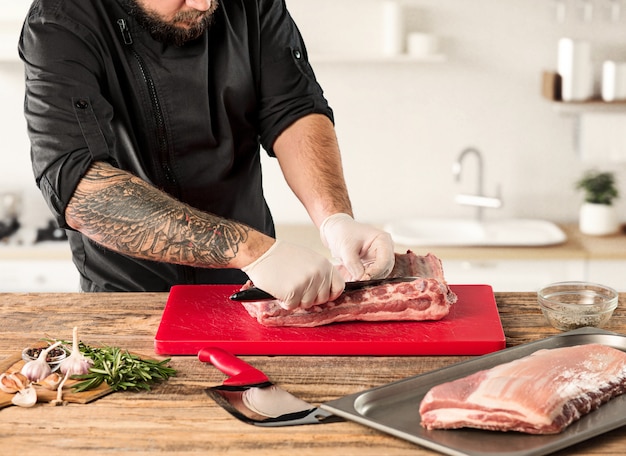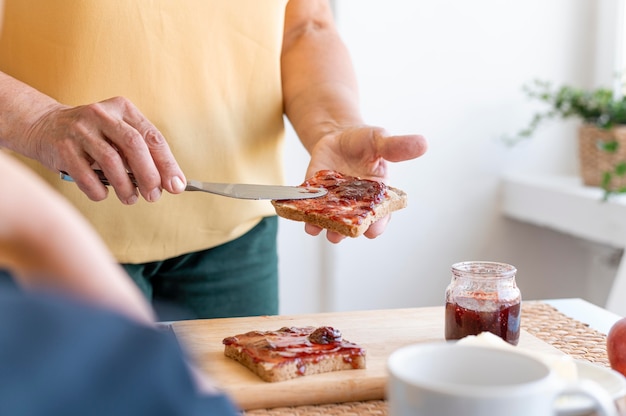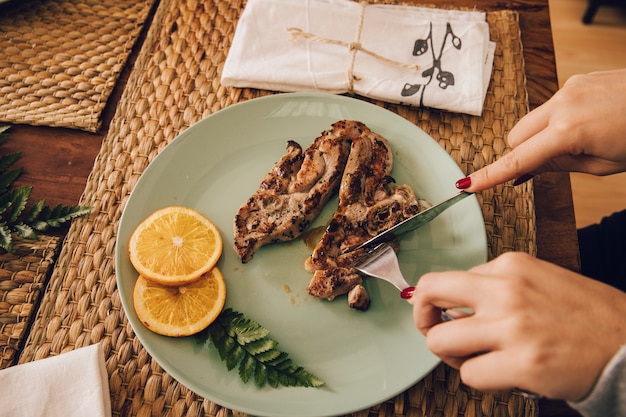Part 1: Understanding the Basics of steak doneness

The Key to a Great Steak: It's All About the Doneness
First things first, let's talk about doneness. It's how much you cook your steak, and it makes a HUGE difference in the texture and flavor. Think about it: A rare steak is practically raw in the center, with a juicy, soft texture. A well-done steak, on the other hand, is cooked through and through, resulting in a drier, firmer bite.Doneness Levels: A Visual Guide
Here's a breakdown of the main doneness levels, so you know what to aim for:- Rare: The inside is cool, red, and incredibly juicy. Think of it like a cool red center with a very slight browning on the outside. A temperature of 125°F/52°C is what you're aiming for.
- Medium Rare: Now we're getting warmer, the red is starting to shift to a slight brown, and the juice is still flowing freely. The center will be warmer and the outside will have a slightly more pronounced brown. Think about a temperature of 130°F/54°C.
- Medium: This is the most popular level, and for good reason! The inside is mostly brown, with a hint of pink, and the juice is starting to get a bit more cooked. The outside will have a nice brown sear. Aim for 140°F/60°C.
- Medium Well: The inside is a nice, even brown, with no sign of pink. The juice is noticeably less abundant. The outside is well-seared. The temperature is about 150°F/65°C.
- Well Done: This is when the inside is fully brown, with no sign of pink, and the meat is dry to the touch. Think about a nice brown color throughout and a very well-seared outside. A temperature of 160°F/71°C.
Remember, the perfect level of doneness is completely up to you. I tend to prefer a medium-rare steak for its juicy tenderness, but there's no right or wrong answer! Experiment with different levels until you find your personal favorite.
Part 2: steak cuts and Cooking Times

choosing the right cut: A Steak Lover's Guide
Now let's talk about the cuts themselves. Not all steak cuts are created equal. Each one has a unique texture, flavor, and fat content, which impacts how it cooks and tastes.- Ribeye: My personal favorite! It's known for its marbling, which gives it an incredibly juicy, flavorful taste. It's the perfect cut for those who like a rich, buttery flavor. I recommend cooking it to medium-rare, but it's delicious at medium as well.
- new york strip: Leaner than ribeye, but still full of flavor. It's fantastic for grilling or pan-searing, and it takes on a lovely crust. It's delicious cooked to medium or medium-rare.
- Sirloin: Another lean cut, but still flavorful. It's a great choice for grilling or pan-searing, and it's a bit more budget-friendly than ribeye or strip. Try it cooked to medium-rare or medium.
- filet mignon: This is the most tender cut of beef, and it's perfect for those who like their steak well-done. It's a bit pricier, but it's worth it for its melt-in-your-mouth texture.
Remember, a thicker steak will take longer to cook than a thinner one. Keep that in mind when planning your cooking times.
Cooking Time Guide: A Starting Point for Your Steak Journey
Here's a quick guide to give you a good starting point for cooking times. These are just estimates, so always use a meat thermometer to get the most accurate reading.| Steak Cut | Thickness (inches) | Rare (125°F/52°C) | Medium-Rare (130°F/54°C) | Medium (140°F/60°C) | Medium-Well (150°F/65°C) | Well-Done (160°F/71°C) |
|---|---|---|---|---|---|---|
| Ribeye | 1 inch | 2-3 minutes per side | 3-4 minutes per side | 4-5 minutes per side | 5-6 minutes per side | 6-7 minutes per side |
| New York Strip | 1 inch | 2-3 minutes per side | 3-4 minutes per side | 4-5 minutes per side | 5-6 minutes per side | 6-7 minutes per side |
| Sirloin | 1 inch | 2-3 minutes per side | 3-4 minutes per side | 4-5 minutes per side | 5-6 minutes per side | 6-7 minutes per side |
| Filet Mignon | 1 inch | 2-3 minutes per side | 3-4 minutes per side | 4-5 minutes per side | 5-6 minutes per side | 6-7 minutes per side |
Remember, these are starting points, not hard and fast rules. Keep a close eye on your steak, and adjust the cooking time as needed. And again, a meat thermometer is your best friend! You don't want to overcook your steak and end up with a tough, dry piece of meat.
Part 3: Cooking Methods: Unlocking Steak Potential

Grilling: A Classic for a Reason
Grilling is a classic way to cook steak, and for good reason. It gives that delicious smoky flavor and those beautiful grill marks. The key is a hot grill. You want the grates nice and hot to sear the steak and create those juicy grill marks. I typically preheat my grill to medium-high heat.Here are a few tips for grilling the perfect steak:
- Oil the Grates: Don't forget to oil your grill grates before cooking. This will prevent sticking and help you get a nice, crispy surface.
- Space It Out: Give your steaks some room to breathe! Don't overcrowd the grill. You want the heat to circulate evenly around each steak.
- One Flip is All You Need: Flip the steak only once. Flipping multiple times will actually make your steak drier, so just flip it over once you've got a nice sear.
Pan-Searing: Quick, Easy, and Delicious
Pan-searing is a fantastic way to cook steak if you're short on time or want a quick meal. It's perfect for smaller cuts of steak, and it's easy to control the temperature.Here are a few tips for pan-searing a steak:
- The Right Pan: Choose a pan that's large enough to hold your steak without crowding it. You want a heavy-bottomed pan so it heats up evenly.
- High Heat and Oil: Use high heat and a good amount of oil to get a nice, crispy sear.
- Don't Move It: Let the steak cook undisturbed for a few minutes before flipping. You want to get a good sear on each side.
oven roasting: For Large Cuts and Multiple Steaks
Oven roasting is a great option for large cuts of steak, or if you're cooking several steaks at once. It's also a great way to control the internal temperature of the steak, especially for those thick cuts.Here are a few tips for oven roasting steak:
- Preheat Your Oven: Preheat your oven to 400°F/200°C.
- Season it Up: Season your steak generously with salt and pepper.
- Use a Rack: Place the steak on a roasting rack to allow air to circulate around it and cook evenly.
- Time It Right: Roast for about 10 minutes per side for a medium-rare steak. Adjust the time based on the thickness and your desired doneness level.
Part 4: Resting the Steak: A Crucial Step for Tenderness
After cooking, the most important step is resting. This allows the juices to redistribute throughout the meat, resulting in a more tender and flavorful steak. It only takes a few minutes, but it makes a huge difference. I recommend resting your steak for about 10 minutes before slicing and serving.Part 5: Temperature Control: Mastering the Meat Thermometer
As I said, a meat thermometer is essential for making sure your steak is cooked to your liking. Insert the thermometer into the thickest part of the steak, making sure it doesn't touch the bone.Signs of Doneness: A Visual Guide
But what if you don't have a meat thermometer? You can also use visual cues to get an idea of your steak's doneness:- Rare: The steak will have a very red center, and it will be cool to the touch.
- Medium Rare: The steak will have a red center with a slight brown ring around the outside.
- Medium: The steak will have a mostly brown center with a hint of pink.
- Medium Well: The steak will have a completely brown center with no sign of pink.
- Well Done: The steak will be completely brown and dry to the touch.
Keep in mind, the most accurate way to know for sure is to use a meat thermometer.
Part 6: steak seasoning: Elevate the Flavor
When it comes to seasoning your steak, keep it simple. Salt and pepper are really all you need! But if you want to add a little extra flavor, here are a few ideas:Basic Steak Seasoning: Salt & Pepper Perfection
The classic! I love to use kosher salt for its larger grain size, and freshly ground black pepper for its intense flavor. Just a generous sprinkle of both will do wonders.
Herb Seasoning: Fresh and Flavorful
Fresh herbs are a delicious way to add another dimension of flavor. Rosemary, thyme, and oregano are great choices. Try rubbing the herbs into the steak before cooking.
Spice Rubs: Unleashing Flavor
Spice rubs can add a bold, complex flavor to your steak. There are so many options available, or you can create your own. Here are a few ideas to get you started:- Garlic Herb Spice Rub: Mix together garlic powder, onion powder, paprika, dried oregano, dried thyme, salt, and pepper.
- Cajun Spice Rub: Mix together paprika, cayenne pepper, garlic powder, onion powder, thyme, oregano, black pepper, and salt.
- Chili Lime Spice Rub: Mix together chili powder, lime zest, cumin, paprika, garlic powder, onion powder, and salt.
When using spice rubs, a light hand is key! You don't want to overpower the natural flavor of the steak.
Part 7: Serving Your Steak: A Flavorful Feast
Your steak is cooked to perfection, and now it's time to create a delicious meal.steak sauces: The Finishing Touch
Steak sauce can really take your steak to the next level. From classic A1 to more gourmet options, there are so many delicious sauces out there to explore. I like to try different sauces to find my favorites.Sides: A Perfect Pairing
Steak goes so well with a variety of sides! Here are a few ideas to get you started:- mashed potatoes: Classic comfort food! They're creamy, comforting, and perfect with steak.
- Roasted Vegetables: Roasted vegetables are healthy and flavorful. Try broccoli, asparagus, carrots, or Brussels sprouts.
- grilled asparagus: Light and refreshing, grilled asparagus is a quick and easy side dish.
- Salad: A salad adds freshness to your meal. I love a simple green salad with vinaigrette dressing.
Part 8: FAQs: Steak Cooking Answers
Now, I know you might have some questions about cooking steak. Here are some of the most common ones:1. How do I know if my steak is done?
The best way to know is to use a meat thermometer. Insert the thermometer into the thickest part of the steak, making sure it doesn't touch the bone. Cook the steak to your desired doneness level.
2. What if I overcook my steak?
Overcooked steak is dry and tough. It's best to avoid overcooking in the first place! Use a meat thermometer to ensure it's cooked to your liking.
3. How do I store leftover steak?
Leftover steak can be stored in the refrigerator for up to 3 days. Wrap it tightly in plastic wrap or aluminum foil. You can reheat leftover steak in the oven, microwave, or on the stovetop.
4. Can I freeze steak?
Yes, you can freeze steak. Wrap it tightly in plastic wrap or aluminum foil, then place it in a freezer-safe bag. Frozen steak can be stored in the freezer for up to 3 months.
5. How do I thaw frozen steak?
The best way to thaw frozen steak is to transfer it to the refrigerator for 24 hours. You can also thaw steak in cold water for 30 minutes to 1 hour. Avoid thawing steak at room temperature, as this can allow bacteria to grow.
There you have it! Now you’re equipped to cook the perfect steak. Go forth, and enjoy!
Everyone is watching

How to Cook Frozen Lobster Tails Perfectly: A Step-by-Step Guide
RecipesLobster. Just the word conjures up images of lavish meals, special occasions, and a taste of luxury. But let's...

Pigs in a Blanket Cooking Time: How Long to Bake for Perfect Results
RecipesAh, pigs in a blanket. Just the name conjures up images of those delightful little parcels of crispy pastry en...

Pork Fillet Cooking Time: How Long to Cook It Perfectly
RecipesPork fillet, or tenderloin as it's sometimes called, is a real favourite in our house. It's so versatile, and...

The Ultimate Guide to Cooking Delicious Frankfurters
RecipesLet's face it, we all love a good frankfurter. It's a classic, simple, and always satisfying. But let's be rea...

Wolf Meat Recipes: A Guide to Cooking Wild Game
RecipesLet's be honest, you don't see wolf meat at your local butcher shop every day. It's a bit of a wild card, but ...
